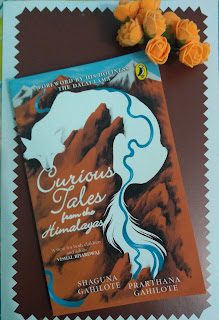Book Review - Curious Tales from the Himalayas by Shaguna Gahilote and Prarthana Gahilote
What is it that draws a reader to folk tales - they impart common sense and a general wisdom without being preachy, they are often told at nap time as we lie in the warmth of our mum's lap or wrapped in a thick blanket? Folk tales, quite steadily and remarkably impart a knowledge of people's way of life in a region, their culture, festivals and traditions; all this being so diverse in a nation like India, we definitely have more reasons than we can count on why we should read and soak up such charming tales.
Why do people of Kumaon garland their kids and offer sweets to the crows in the region on Makara sankranti day? What is the tale behind Ghode Jatra held in Tundikhel, Kathmandu? Who was Gurumapa, the ogre and why people leave a feast on the open grounds of Tundikhel? How did the river Teesta get its name? Why do newly married couples in Sikkim walk to the confluence of Rongnyu and Rongeet rivers to seek blessings? Do the skylarks singing a peculiar tune along the river Brahmaputra in Assam villages have a story to tell?
We get to know the answers for all these questions and witness much more - monkeys with abundant love for sweet potatoes, meditating frog monk, magical herb called Kala paaja and a Rumplestiltskin style folktale from Bhutan in this slim and beautiful book.
Giving room for some additional thought - how important in forming an opinion is a foreword, an introduction or an author's note in the book you read?
The Gahilote sisters, authors of this book, very beautifully describe the relevance of folktales. Often bundled with a share of ups and downs, magic and realism, these tales impart valuable lessons without being preachy; the witches, evil spirits and demons in them only being manifestations of man's negative emotions.
They assert the importance of story telling, how stories need to be rendered as is, free of labels so that children have a free run of imagination and manage their own interpretations sans a compulsive intent of finding a moral towards the end.
When they say stories are constantly being lost to technology and cool gadgets, stories have a shelf life far longer than fads and trends, we vehemently agree.The author's introductory note ends with these beautiful lines -
"Stories last for generations, reviving themselves around campfires, spitting up flames, hibernating during winter and blooming again with the spring's sun, spreading like the fragrance of the rhododendrons in the Himalayas for anyone who wishes to drink them in and share!"
An author's note speaks a great deal of the message he/she wishes to convey through a written work, which more than a culmination of efforts is actually a beginning of a long journey for the author, a journey where they willingly carry every reader along.
Few books in which I loved the author's note are listed below -
1. The deal of a lifetime - Fredrik Backman , the prologue made me buy it.
2. Remnants of a separation by Aanchal Malhotra
3. Poonachi - Perumal Murugan, when he says why he chose to write on animals, why goats, you know this man will never mince words, everything is raw and upfront.
4. Liberation of Sita by Volga - author's note speaks of her pragmatic ideas to impart a strong message and fill voids in the epic.
Getting back to the review, this book is a short read that leaves really big smiles on your face and a child like happiness and satisfaction.
Recommend it wholeheartedly for those who hail from Himalayan hill towns, to those who want to soak up the beauty of these enchanting places but never visited them, to those who visited these places and want to relive few moments of that magic, to those who love happy and light reads and love to read tales aloud to their little ones - their own kids, nephews, nieces and all tiny tots.

No comments:
Post a Comment